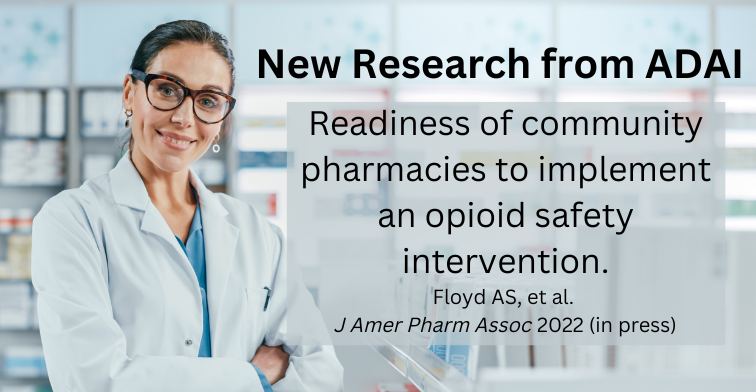New Research from ADAI: Opioid Safety Intervention for Community Pharmacists
11/07/2022
ADAI Research Associate Professor Anthony Floyd, PhD has a new paper out describing an assessment of community pharmacists’ readiness to implement an educational program that aims to boost their knowledge and confidence when it comes to providing opioid safety and harm reduction services to patients and customers.
What is the context for this study?
Community pharmacies are ideal places for improving opioid safety and increasing access to harm reduction materials like syringes and naloxone, but a number of studies have found that pharmacists are not always comfortable engaging in these practices.
Some of that reluctance could be explained by lack of knowledge or confidence, however, something education and other supports could help improve.
What did researchers want to find out?
An intervention called Respond to Prevent, which includes both online and in-person components, has been developed for pharmacists to increase knowledge and awareness of opioid harm reduction best practices, while encouraging naloxone provision, sales of nonprescription syringes, and buprenorphine dispensing.
Before testing out delivery of this intervention, researchers in this study wanted to assess readiness to adopt it, by asking pharmacists to describe current practices and challenges around interacting with patients on naloxone, nonprescription syringe sales, and buprenorphine; and determining pharmacy-defined goals for implementing the intervention.
How did researchers conduct this study?
Dr. Floyd and colleagues interviewed 163 pharmacy managers and staff pharmacists from two large chains via phone. Interview questions focused on workplace culture, patient engagement, naloxone and buprenorphine prescribing, nonprescription syringe sales, and intervention goals.
What did researchers learn?
Based on their interview responses, pharmacists appear to be largely aware of and receptive to opioid safety initiatives and are already engaging in some opioid safety education with their patients, including naloxone dispensing and educational counseling.
Most of the pharmacists interviewed endorsed feeling ready to promote the Respond to Prevent intervention, and said they hoped it would provide them with:
- more knowledge and educational materials,
- some talking points to use with patients,
- information on best practices for offering naloxone.
What are the implications of these findings?
Pharmacies play a critical role in the overall health and well-being of their communities, and interventions are needed to help boost pharmacists’ knowledge, confidence, and skills in supporting opioid safety and harm reduction. By identifying what knowledge levels, workplace culture, and barriers exist for community pharmacists, educational interventions like Respond to Prevent can be better tailored to address a pharmacy’s specific needs, increasing the likelihood of successful and effective intervention.
Citation: Floyd AS, et al. Readiness of community pharmacies to implement an opioid safety intervention. Journal of the American Pharmacists Association 2022 (in press). doi: 10.1016/j.japh.2022.10.031
*Need help getting a copy? Email adai@uw.edu for assistance!





